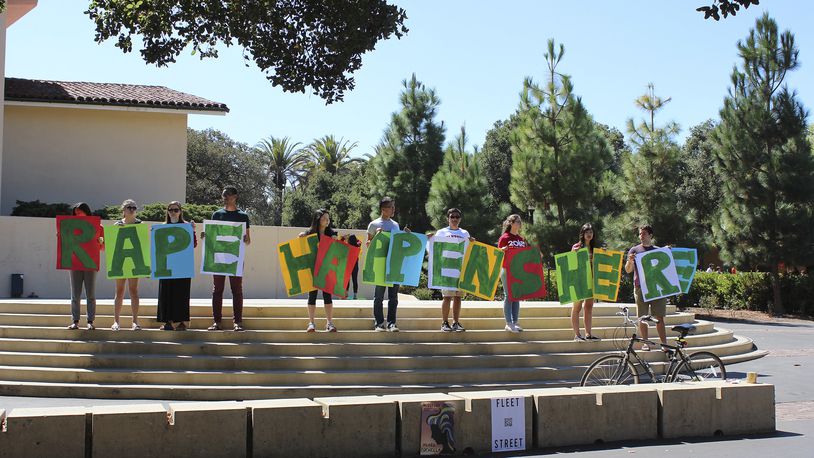Sexual assault reports at area college campuses/2015
Ohio State University: 30
University of Cincinnati: 18
Miami University: 17
University of Dayton: 8
Wright State University: 5
Wilberforce University: 2
Antioch College: 1
Wittenberg University: 1
Sinclair Community College: 0
Clark State Community College: 0
Cedarville University: 0
Central State University: 0
Source: Clery reports
Note: Differences in how schools define and report sexual assaults and residential student populations make it unadvisable to compare schools to each other using this data.
The total number of reported sexual assaults at area colleges and universities increased last year, according to federally mandated reports released by schools across the country this month. But experts say this is not cause for alarm.
“It is important to note that higher numbers does not necessarily mean unsafe,” said Allison Kiss, executive director for the Clery Center for Security on Campus. “Often this means that students are comfortable reporting and know how to report. If a campus does a lot around awareness, typically we see numbers increase.”
There were 82 sexual assaults reported in 2015 at 12 regional public and private universities, from Ohio State University to the east to the University of Cincinnati to the south. These doezen schools had 72 sexual assaults in 2014.
The numbers come from reports each school was required to post online this month under the federal Clery Act. Issues with inconsistent reporting at campuses have created problems with using the numbers to compare the safety of one campus to another.
The numbers also reflect only crimes reported on campus. An I-Team investigation this year found that three University of Dayton students reported three alleged rapes in the student neighborhood to UD police in 2014, for example, but they were not included in the 2014 Clery numbers because the incidents were not tied to university-owned property.
The new numbers show rapes reported at UD increased from four in 2014 to eight in 2015.
Not all schools saw an increase. Miami University had 17 reported sexual assaults in 2015 and 18 in 2014.
“Sexual assault is still an under-reported crime and we continue to strive to provide options and resources to those who experience these crimes, including police reporting, university reporting, and confidential resources,” said Becca Getson, sexual assault response coordinator at Miami.
Wright State University changed how it reports rapes, so the five reported sexual assaults at WSU in 2015 can’t really be compared to previous years.
The Ohio Attorney General’s Office on Friday awarded WSU a $156,500 grant to develop a mobile app to help victims of sexual violence gain access to campus and community resources.
Convictions rare
A new federal law makes the Clery reports more of a handbook for students than previous years by requiring schools to list their policies.
“These statements offer an overview of prevention programs, how to report crimes, drug and alcohol policies, services for victims, and other crime-related information,” Kiss said.
The report lists all kinds of crimes — drug and alcohol violations were down at UD but up at Miami and Cincinnati — but they come out this year amid heightened discussion of campus sexual assault in the wake of the controversial punishment given to Brock Turner of Bellbrook for a sexual assault at Stanford University.
Last week, a jury acquitted a Wittenberg student accused of sexually assaulting three fellow students.
Katie Hanna, executive director of the Ohio Alliance to End Sexual Violence, said one in five college women suffer sexual assault.
The I-Team’s investigation this year found that most sexual assaults at Ohio colleges are not reported to campus authorities. Many that are reported are not referred to police. And of those that are, few lead to arrests and almost none lead to a conviction.
“We see increased reporting numbers as a sign that students know where to go,” Hanna said. ““It doesn’t mean it’s happening at a higher rate, it just means there’s higher reporting of it.”
Some report zero
In fact, there is some concern when universities report unusually low numbers. Central State University and Cedarville University both reported zero sexual assaults last year and the year before, which advocates have said “defies reality.”
Wilberforce University, across the street from Central State and much smaller, reported three sexual assault in the past three years. Tiny Antioch College, also in Greene County, reported one last year.
Massive Ohio State University, on the other hand, had 30 reported sexual assaults in 2015, up from 22 the year before.
Hanna said one mechanism to increase reporting of assaults is to ease requirements that certain people report them to police. A bill to do this is pending in the Ohio Senate.
She said survivors should be allowed to reach out to counselors, social workers and rape crisis centers without immediately entering the intimidating criminal justice system. She believes more people would ultimately report to police if they were able to do so on their own terms after getting support.
“They can get support, they can reach out, but it doesn’t automatically start this investigation because often that is a barrier,” Hanna said.
About the Author
